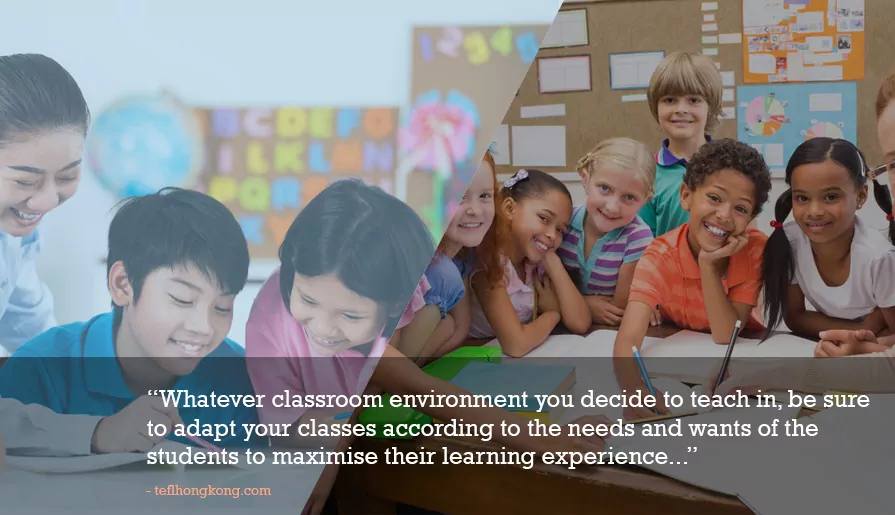
- By: Billie Jago
- In: For Teachers
In any job you’ve been doing a long time, it can become repetitive. You may have been teaching for a while, and are now wondering how to bring back that spark you had when you first started teaching English as a foreign language, or you may be thinking about broadening your experiences in the TEFL world and venturing into a new type of classroom.
There are a multitude of ways you can teach English, but the common types of classroom settings are likely to be multilingual, and monolingual. So, what’s the difference?
Monolingual classes contain students with a common native language, or L1. You may typically find these types of classes abroad.
A multilingual class is made up of a mix of nationalities and languages and is predominantly found in native English-speaking countries.
There is also a hybrid phenomenon, called a predomonolingual class. This is when you have a majority with one language, mixed in with a few other backgrounds. For example, a majority Chinese-speaking class with a Spanish student and a Japanese student too.
Also Read:
- Differences between East Asian and European Language Learners
- An English Only ESL Class – Is it possible?
Teaching Differences
Your teaching technique may differ depending on which type of class you are teaching. With this in mind, it’s essential to consider the differences between both class types.
Monolingual classes
Disadvantages
Some of the struggles may be trying to get the students to discuss and debate in English. If students share a native language, they may automatically revert back to this, even if they don’t realise it.
Similarly, if you are teaching lower levels, it may be easier for students to ask their peers for a translation or for help if they need it.
If you do understand some of the main language in the classroom, don’t let the students become aware of it. The ultimate goal is to maximise the use of English in the class, and student’s may become reliant on your knowledge of their native language to translate or explain things to them.
Advantages
Students will have a common culture within the class, and this can be used to a teachers’ advantage. Lessons can be personalised, opinions on their country and its society can be shared, and students will easily be able to relate the language they are learning to situations outside of the classroom.
Lessons can be tailored to your students needs, and errors can easily be identified – most of the student’s will have the same language, grammar or pronunciation problem.
Multilingual classes
Disadvantages
As there will be no common country or background within the classroom, lessons will need to be carefully planned to ensure cultural sensitivities have been taken into consideration.
Grouping for tasks may need to be thought out in advance, as well as any tasks that may involve students sharing their points of view about potentially divisive topics.
Advantages
Ensuring that English is the language of instruction and discussion in the classroom is easiest in this classroom environment. Student’s have ample opportunity to express themselves orally, and the ability to mix with, and learn from, other cultures and backgrounds.
It can be an enriching experience not only for the language being learnt, but also by opening student’s minds up to the world and its diversity.
Teaching at Home vs Teaching Away
Whether you decide to teach in your own country or travel abroad, TEFL teaching is a rewarding experience that you yourself can also learn from.
When teaching in your home country, you’ll need to consider that most students will also have the element of culture shock and homesickness, piled on top of their nervousness of being in an English-speaking country. So, how to overcome this?
- Ensure the lessons are personalised to the students, so they have the chance to share their own feelings and ideas.
- Ensure you pair up students depending on their level and confidence. This will help them come out of their shell and make friends quickly.
- Encourage peer learning. This helps students learn from each other and motivates them to continue to learn outside of the classroom.
- Allow students to make decisions about their own learning. Offer choices of tasks and activities, and have students choose certain topics or units for the lesson.
- Give, and receive, If you don’t have time for one-on-one tutorials, allow students to write one thing they enjoyed about their lesson and one thing they would like to do or improve next time. This will help you to see how students are feeling, without putting them on the spot
When teaching abroad or away, student’s may react differently to an often dynamic EFL teaching method; something which may be foreign to what they’re used to and it therefore may take time for them to adjust to.
- Ask students how they normally do certain tasks or practise certain skills. You can then see what they are used to and introduce new tasks, or ways of doing things, slowly.
- Consider that students may not be used to speaking in certain countries, receptive skills such as listening and reading take priority over productive skills.
- Consider respect levels. In many countries, teachers are well-respected and are in a strong position of authority. At the beginning of a new course, don’t be afraid to set some light-rules for students to follow. For example, calling you by your first name is fine, and students don’t have to stand up when you enter a classroom.
Whatever classroom environment you decide to teach in, be sure to adapt your classes according to the needs and wants of the students to maximise their learning experience.
Here is another article that speaks about different teaching methods you can adapt as a teacher. Go ahead and check your style of teaching.
Please Share:This article was originally published on October 22, 2019 and was last updated on January 14, 2021.
Courses We Offer:

1. CertTESOL: Certificate in TESOL
A level 5, initial teacher training qualification for new and experienced teachers, enabling you to teach English anywhere in the world. The course is equivalent to Cambridge CELTA.
Learn More
Developed by our Trinity CertTESOL experts, for a comprehensive, self-paced learning experience. Earn an internationally recognized certificate and master essential teaching skills, accessible globally 24/7.
Learn More